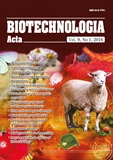ISSN 2410-7751 (Print)
ISSN 2410-776X (Online)

"Biotechnologia Acta" V. 9, No 1, 2016
https://doi.org/10.15407/biotech9.01.087
Р. 87-96, Bibliography 18, English
Universal Decimal Classification: 547.953:615.012
LIPOSOME STABILITY DEPENDENCE ON FATTY ACID LECITHIN COMPOSITION AND PHOSPHOLIPIDS SUNFLOWER
State Enterprise “Institute for Food Biotechnology and Genomics of the National Academy of Sciences of Ukraine”, Kyiv
Phospholipids play an important physiological role being components of biologically active membranes of animals and humans nerve cells. Identification of phospholipids while they are being separated through high performance liquid chromatography method is usually carried out by absorption in the ultraviolet region of the spectrum or refractometrically. Phospholipids can be subjected to separating both in native form, and in the form of derivatives. Unmodified phospholipids can be detected by absorption at a wavelength of 205 nm. The conditions of separation of sunflower phospholipids are defined owing to the method of high performance liquid chromatography (HPLC) with detection in UV range, and the method of phosphatidylcholine, phosphatidylethanolamine and phosphatidyl inositol determination through quantitative test have been developed. It was done under normal phase mode and according to external standards and the order of their release. Phospholipid composition of sunflower lecithin has been identified, and phospholipid fatty acid composition through the method of tandem mass spectrometry has been determined. The presence of antioxidant α-tocopherol has been determined in liposomes composition, which manifests a condition for maintaining stability of liposomal substance. Membrane-protecting effect of α-tocopherol is associated with its participation in arrangement of the membrane structure through direct interaction of its side isodental chain with polyunsaturated fatty acids of phospholipids, which leads to denser packaging of mitochondrial membranes and the rise of increased resistance to lipid peroxygenation process effect.
Key words: lecithin, sunflower phospholipids, fatty acids, liposomes
© Palladin Institute of Biochemistry of the National Academy of Sciences of Ukraine, 2008
References
1. Sulkowski W. W., Pentak D., Nowak K., Sulkowska A. The influence of temperature, cholesterol content and pH on liposome stability. J. Mol. Struct. 2005, V. 744, Р. 737–747.
2. Yadav A. V., Murthy M. S., Shete A. S., Sfurti S. Stability Aspects of Liposomes. Ind. J. Pharm. Edu. Res. 2011, 45 (4), 402–413.
3. Liposome Drug Products. Chemistry, Manufacturing, and Controls; Human Pharmacokinetics and Bioavailability; and Labeling Documentation. Guidance for Industry. U. S. Department of Health and Human Services, FDA, CDER. October 2015. Pharmaceutical Quality/CMC Revision 1.
4. Rasti B., Jinap S., Mozafari M. R., Yazid A. M. Comparative study of the oxidative and physical stability of liposomal and nanoliposomal polyunsaturated fatty acids prepared with conventional and Mozafari methods. Food. Chem. 2012, V. 135, Р. 2761–2770.
5. Araseki M., Yamamoto K., Miyashita K. Oxidative Stability of Polyunsaturated Fatty Acid in Phosphatidylcholine Liposomes. Biosci. Biotechnol. Biochem. 2002, 66 (12), 2573–2577.
6. Chen Irene A., Szostak Jack W. Membrane growth can generate a transmembrane pH gradient in fatty acid vesicles. PNAS. 2004, 101 (21), 7965–7970.
7. Shulga S. M., Glukh A. I., Glukh I. S. Development of technology for obtaining dry lecithin from sunflower phosphatide concentrate. Sci Innov. 2012, V. 8, Р. 62–71. (In Russian).
8. Hollo J., Peredi J., Ruzics A. et al. Sunflower lecithin and possibilities for utilization. JAOCS. 1993, V. 70, P. 997–1001.
9. Budai L., Kaszas N., Grof P. Liposomes for topical use: a physico-chemical comparison of vesicles prepared from egg or soy lecithin. Sci Pharm. 2013, V. 81, P. 1151–1166.
10. WHO/CDS/NTD/IDM/2007.4. Report of a WHO informal consultation on liposomal amphotericin B in the treatment of visceral leishmaniasis, Rome, Italy, 16 April 2005:World Health Organization, 18 p.
11. Henschen A. K-P. Hupe, Lottspeich F., Voelter W. High Performance Liquid Chromatography in Biochemistry. Edited by A. Henschen K-P. Hupe. Verlag Chemie, Weinheim. 1986. P. xiii + 638.
12. Shulga S. M., Glukh I. S. Dry powder lecithin and liposomal nanoemulsions from sunflower. Аbstracts of posters 10th ILPS Phospholipid Congress, Rotterdam, the Netherlands, 16–18 September 2011, Р. 6.
13. Rustan A. C., Drevon C. A. Fatty Acids: Structures and Properties. Encyclopedia of life sci., John Wiley & Sons. 2005, Р. 1–7. doi: 10.1038/npg.els.0003894.
14. Raynor A., Jantscheff P., Ross T., Schlesinger M., Wilde M., Haasis S., Dreckmann T., Bendas G., Massing U. Saturated and mono-unsaturated lysophosphatidylcholine metabolism in tumour cells: a potential therapeutic target for preventing metastases. Lipids in Health and Disease. 2015, 14 (69), 1–15. doi: 10.1186/s12944-015-0070-x.
15. Melnyk Andrii K., Sukhoveev Olexandr V., Kononets Lyudmyla A., Khilchevsky Olexandr M., Shulga Serhiy M., Kukhar Valery P., and Vovk Andriy I. An EPR spin probe study of liposomes from sunflower and soybean phospholipids. J. Liposome Res. 2015, Early Online: 1–7, Informa Healthcare USA, Inc. doi: 10.3109/08982104.2015.1039031.
16. Roselena S. Schuh, Fernanda Bruxel, Helder F. Teixeira. Physicochemical properties of lecithin-based nanoemulsions obtained by spontaneous emulsification or high-pressure homogenization. Quim. Nova. 2014, 37 (7), 1193–1198.
17. Schnitzer E., Pinchuk I., Lichtenberg D. Peroxidation of liposomal lipids. Eur. Biophys. J., 2007, V. 36, Р. 499–515.
18. Reis A., Spickett C. M. Chemistry of phospholipid oxidation. Biochim. Biophys. Acta. 2012, V. 1818, Р. 2374–2387.

